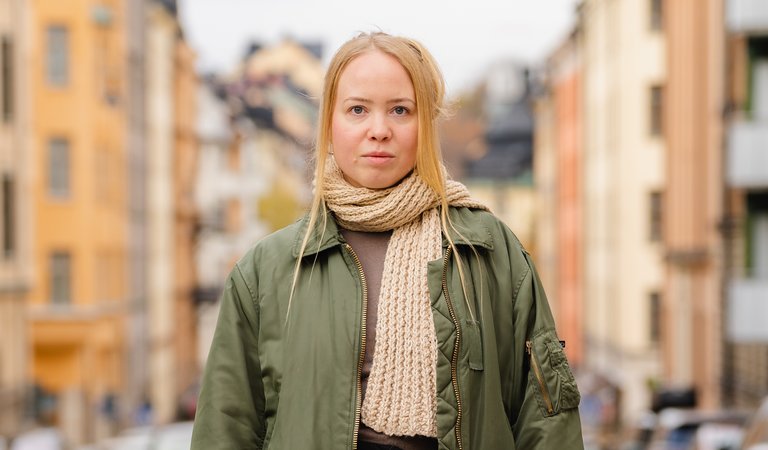Saga Loxdal: My 5 hidden Stockholm Gems
Publish date: 5 March 2025
So, you’ve checked Gamla Stan, City Hall, and the Vasa Museum on your to-do list. What next? We asked Saga Loxdal, better known as SagasOkändaSTHLM, about her best tips located of the beaten path.
Saga Loxdal is fascinated by architecture and urban development in general, and Stockholm in particular.
The lifelong Stockholmer and former copywriter has turned her love for the city into a part-time occupation. Saga shares tips on hidden or forgotten Stockholm gems as SagasOkändaSTHLM on TikTok and Instagram and has also organized guided tours about the history of lesser-known locations in town.
“I guess I like everything, and have a hard time choosing”, Saga replies, when asked if she prefers a particular style or era in Stockholm architecture.
“1920s-era buildings are beautiful, great if you want to view the city through a romantic lens. The post-WWII ABC städer*, like Vällingby or Hökarängen, are incredibly cozy. It's as if urban planners drew up life. And let's not forget the scores of magnificent 1700-1800s buildings, full of history... really, anything but new buildings”.
*ABC Städer = "ABC Towns". A style of urban planning popular in the 1940s-50s. The idea was to minimize the need for commuting by having Arbete (places of work), Boende (residential housing), and a Centrum (a commercial area with shops, businesses, and cultural venues) within walking distance from one another. Vällinby and Farsta are two ABC Städer in Stockholm.
Some of Saga’s tips are relatively known – at least to the locals – and full of activity. Like St. Mark’s Church in Björkhagen, an excellent example of 1950s brutalist architecture, or the semi-guerilla allotment gardens along a discontinued stretch of railroad on Södermalm.
Others are obscure and hard to find even for Stockholmers. Like Drottninggrottan on Nåttarö Island (“The Queen’s Cave”) where Queen Maria Eleonora hid during her escape back home to Brandenburg. Some of Saga’s posts also cover derelict houses that have been left empty in the middle of town.
"I think people would be shocked if they realized how many buildings in town are empty, for one reason or another. Some are soon-to-be-demolished, but others are empty simply because the landlords don't want tenants. But I just want to make it clear that I'm not an urban explorer – I keep a safe distance from vacant buildings"
Saga Loxdal's 5 Hidden Gems in Stockholm
- Högdalstoppen: “Högdalstoppen is a group of viewpoints in southern Stockholm, between Högdalen, Hökarängen and Fagersjö. It’s probably lesser known than Hammarbybacken, and maybe even a tad less accessible. For example, the path up to the highest peak is a bit awkward. But I love the walk, especially during winter, and the view is excellent. The best in Stockholm, in my mind. There used to be a luge track here, but it was dismantled in the 90s. You can still find traces of it, though”.
- Per Olof Hallman’s projects: “Per Olof Hallman was a famous Swedish architect and Stockholm’s first official urban planner. He was instrumental in planning neighborhoods like Lärkstaden in Norrmalm, Atlasområdet on Kungsholmen, and Aspudden south of Stockholm. All his projects are beautifully planned, with their irregular buildings. He had an affinity for designing archways, which I love. It’s like you’re stepping through a portal to discover the neighborhood beyond.”
- Museum apartments: “There are lots of great museum apartments in Stockholm showing how regular people have lived through the years. All you need to do is to book a guided tour. Some are under the care of the City Museum, others are overseen by private foundations or cultural societies. For example the Barnrikeshusen at Roslagstull – a block of affordable 1940s residential buildings for families with multiple children – and the spectacular 1880s Stuckatörens våning (“the plasterer’s apartment”) in Norrmalm. Then there’s a great 1960s Miljonprogram apartment in Tensta and the rustic Blockmakarens hus from 1917 on Södermalm. My favorite though is Astrid Lindgren’s flat overlooking Vasaparken. Everything has been left just as it was before her passing. Be sure to book your visit well in advance though, as the waiting list is long.”
- Haga castle ruins: “Haga Castle Ruins (Haga slottsgrund) isn’t so much a castle that has been abandoned, but rather one that was never finished. King Gustav III commissioned the castle in Solna, and construction started in the 1780s. However, the project was abandoned after the King’s assassination in 1792. The foundation and cellars is still there, in the grove just north of the current Haga Palace. The ruins cannot be entered as they are classified as a protected site, but you can get a great view from the right side of the walls. A cool piece of trivia is that the duel between Mattis and Borka in Ronja Rövardotter (1984) was filmed here!”
- Johanneshov’s sconce: “Located near Avicii Arena and Globen Shopping Mall are parts of an old military fort, Johanneshov’s sconce. A sconce is a defensive construction built to have a clear view in all directions, often shaped like a star. Construction on the sconce began in 1859 but was abandoned in 1860. This type of military construction had essentially become dated. Parts of the defensive wall are visible in the reception of an office building and since it's classified as a “national heritage”, anyone to go and have a look-see (during office hours). I think it’s fascinating to imagine how the area might have looked with a military fort, instead of the arenas and office buildings”.
